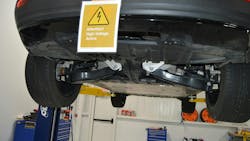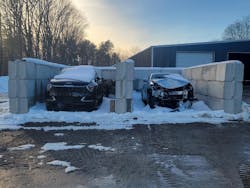Are you making extensive upgrades to your shop – or even planning a new facility? If so, have you considered how to allow for repairs of electric vehicles (EVs)?
There are around 275 million registered vehicles in the United States. Just under 3.5 million of those – roughly 1.25 percent – are EVs.
Despite that relatively low number, there is data to suggest that EVs are continuing to pick up momentum and continue to embed themselves in the mainstream. According to Edmunds, around 1.07 million new EVs were sold last year – more than four times as many since 2018 – and EVs accounted for 7.5 percent of all new vehicle sales in the U.S. in 2023.
There are also pockets of the country where EVs are much more popular. California, Texas, and Florida account for roughly a third of the country’s total EV population.
Adoption of electric vehicles is happening, slowly but surely, and if you are thinking about or are already in the process of building a new collision repair shop, it may be a wise long-term investment to design it with EVs in mind.
Dirk Fuchs, founder and owner of Electric Mobility Consulting and a leading expert in the EV space, says getting into EV repair now – if it makes sense for your shop – can open up a lot of opportunities in the future.
“There are new EV manufacturers coming out it seems every month,” Fuchs says. “EV upstarts are going to need a repair network in the future – that could be a good opportunity.”
When designing a new space, there are a few considerations that should be made to ensure the short-term success and long-term vitality of your shop.
Making Space
EVs are, structurally speaking, very similar to ICE vehicles when it comes to collision repair. In fact, EVs have fewer moving parts than ICEs, which makes them simpler to repair in terms of mechanical work.
However, there are some special considerations that need to be made.
“The first thing I would consider when you build a shop layout is to determine where you would like to repair EVs,” Fuchs says. “Most places aren't going to go 100-percent EV repair. It'll probably be a mixture of EVs and ICE vehicles, but as your repair more EVs, more EVs will come in.”
Fuchs says you have to decide where you’re going to do your “clean” work and your “dirty” work. EV batteries and electrical circuits are incredibly sensitive and susceptible to contamination – Fuchs says he’s heard several horror stories of shops doing a good job on a repair but didn’t cover the electrical components very well.
“The customer picks up the vehicle, and on their first longer drive, they put the throttle down and the battery catches on fire,” he says.
Making sure that your new shop has a designated spot for work to be done when electrical components are exposed and making sure they’re covered during “dirty” work such as grinding and other structural repairs is vital to make sure those components aren’t compromised.
In spaces where your team will work on both EVs and ICE vehicles, Fuchs recommends making sure that equipment such as lifts and scissor tables are graded specifically for EVs. Otherwise, you may not have enough room to remove a battery and perform necessary repairs.
“To remove an EV battery, you need a two-post lift with four arms,” Fuchs says. “When putting a lift in place, you need to ask the provider if its suitable for the heavier weight of an EV, that the lift can provide the clearance under the car to drop the battery pack, and then this lift is usable on any car that comes into your car. Some lifts can even use brackets that lift a car from under the tires. Then you get even more clearance that allows you the space to operate.”
In addition, Fuchs says your new space needs to have a clear exit strategy should a fire break out or something else goes wrong with an EV during a repair. Making sure that your team would be able to get a vehicle through your shop, outside, and into the isolation area quickly without damaging other vehicles or your shop is an important factor to consider when designing the overall layout of the space.
NHTSA requires 50 feet of clearance from any buildings, vehicles or other combustible materials for an EV that needs to be isolated. There are several ways to achieve this, but Fuchs suggests building a U-shaped isolation area using construction-grade bin-blocks with clearance just high enough to get the vehicle in. (Editor's note: For more information and detailed engineering drawings for these, please refer to the image gallery in this article.)
One final space consideration to account for is where an EV’s battery goes once it’s out of the vehicle in your shop. According to the National Fire Protection Association’s NFPA 855 Standard Development guidelines, batteries that are out of a vehicle for longer than 48 hours need to be placed in long-term storage.
Fuchs says having a designated building on your land that is climate controlled – 70 degrees is the “sweet spot” for storing lithium-ion batteries – and has carbon monoxide monitoring is the ideal spot to put batteries that need to go in long-term storage.
Safety Features
EV fires are a real risk, and making sure your shop is equipped to detect any potential dangers is key.
When an EV battery begins to off-gas, a clear sign that a fire igniting is possible, it emits four different kinds of gases: hydrogen, hydrogen fluoride, carbon monoxide and carbon dioxide. Fuchs says an off-gassing EV battery will start to smell similar to cherry bubble gum. But by that point, there would already be a large amount of toxic gas in your shop.
Instead, he recommends installing a carbon monoxide detection system that can send alerts to your phone. That way, no matter what time of day or where you are, if a battery starts to off-gas at your shop, you’ll know and will be able to contact your local fire department.
“I would include my fire department in those conversations from the beginning so that they're aware of what you do and what vehicles you're working on,” Fuchs says.
Identifying a problem before it catches fire is ideal, though, and having the tools to properly diagnose an EV is essential. Fuchs recommends deciding on which brand of EVs your shop will work on and getting all the proper diagnostic tools from those OEMs.
“I feel much safer knowing that we use all the tools the manufacturer recommends,” he says.
Beyond that, Fuchs says making sure your team is trained is essential, both in terms of performing the best repairs for your customers and to making sure that any accidents can be avoided or properly handled.
“Education, of course, is also a big point. Make sure all your staff gets the right training, goes through a certification program specifically for EVs,” Fuchs says. “That way, you can tell customers that they are getting a certified technician regardless of who's working on the vehicle.”
Properly equipping your team with PPE is also necessary. Each OEM has different PPE requirements when working on their vehicles, so make sure to follow their guidelines when purchasing equipment.
Charging
The last piece of advice Fuchs has surrounds electricity. Having multiple chargers is important if you’re working on several vehicles at a time.
“I want to give a customer back a clean car that's nicely repaired with a fully charged battery. That's a service we want to provide.”
Level 2 chargers cost around $1,000 to purchase and install, though they take a few hours to get most vehicles to a full charge. If your shop wants to make a larger investment, Level 3 Fast Chargers have more than twice the total voltage of Level 2 at 480 volts. Fuchs says only around 1 percent of industrial buildings in the U.S. are built to carry that much power, but if your shop has the ability to install them, it will be listed as an official Level 3 charging station that will be “on every map that tracks charging stations.”
At the end of the day, building a shop with dedicated EV capabilities is a large investment, but if done correctly, could pay big dividends down the road.
About the Author

Noah Brown
Noah Brown is a freelance writer and former senior digital editor for 10 Missions Media, where he facilitated multimedia production several of the company's publications.

